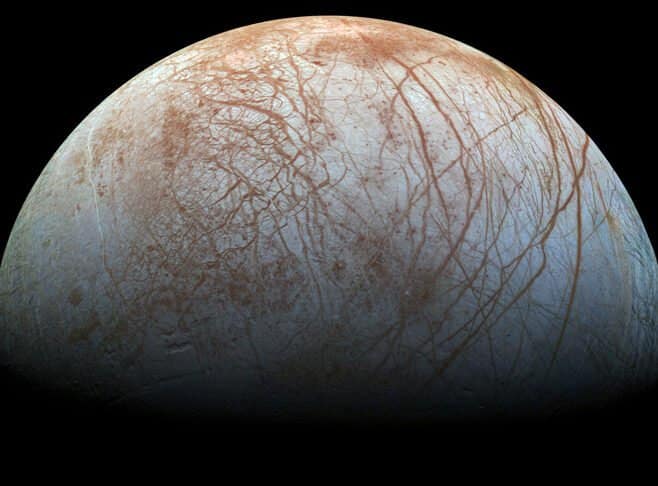Jupiter is not just the biggest planet in our solar system, it is also one of the most enigmatic. With a size 317 times that of Earth and 2.7 times greater than all the other planets combined, Jupiter boasts a ring system and numerous moons.
Engagement Bands
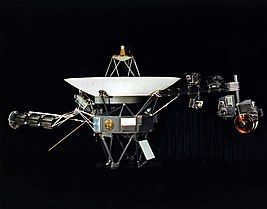
The rings of Jupiter were initially discovered by the Voyager 1 spacecraft during its flyby of the planet in 1979.
Further investigation into the composition of the rings began in 1990, with the assistance of the most advanced telescopes available. It was then determined that the planet’s rings are comprised of rocks and dust.
Like other gas giant planets, Jupiter also possesses rings. However, Jupiter’s rings are smaller and less prominent compared to Saturn’s rings, as they are fainter and thinner.
Most theories suggest that the rings formed through collisions between Jupiter’s moons and are composed of cosmic dust and small meteorites. The rings may have also formed as a result of the strong gravitational pull of the massive planet, which easily attracts celestial objects.
In total, there are four rings surrounding Jupiter.
- Halo – a ring.
- The primary ring.
- Amalthea’s ring of webs.
- The web ring of Thebes.
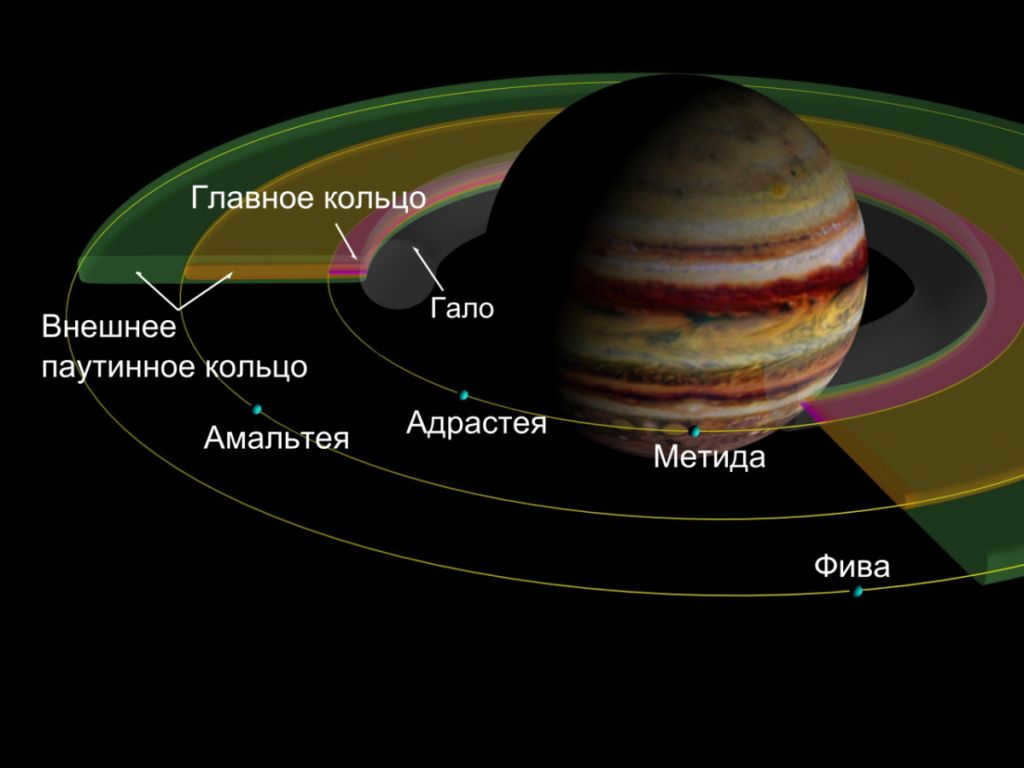
The closest ring to Jupiter, known as the Halo, is thin and weak, and it merges with the main ring. Inside the main ring, you can find the satellites Adrastea and Metida. The Spider Ring has a structure that resembles smoke or fine dust.
Every two weeks, the dust-like rings around Jupiter settle on the planet’s surface, so regular new formations of rings are necessary to maintain their permanent existence.
Jupiter’s moons were first observed by Galileo Galilei in 1610. Nowadays, these moons are categorized as:
What is the total number of Jupiter’s moons? Jupiter has a total of 79 moons, which are continuously being researched by scientists.
Several of Jupiter’s moons are as large as small planets, such as Mercury. There have been claims of water being present on certain moons. The largest of Jupiter’s moons are named Io, Ganymede, Callisto, and Europa.
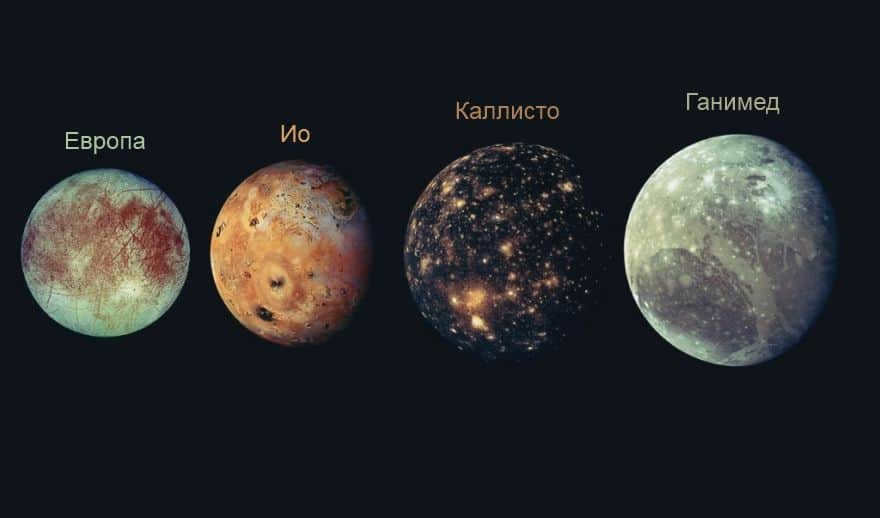
Io
Io is a large moon of Jupiter that is known for its active volcanoes. It is one of the Galilean moons, which were first observed by Galileo Galilei in 1610.
Io has an iron core surrounded by a thick layer of silicate rocks. There are also small glaciers in certain areas. The moon has impressive mountain ranges, with peaks reaching heights of around 18-19 km.
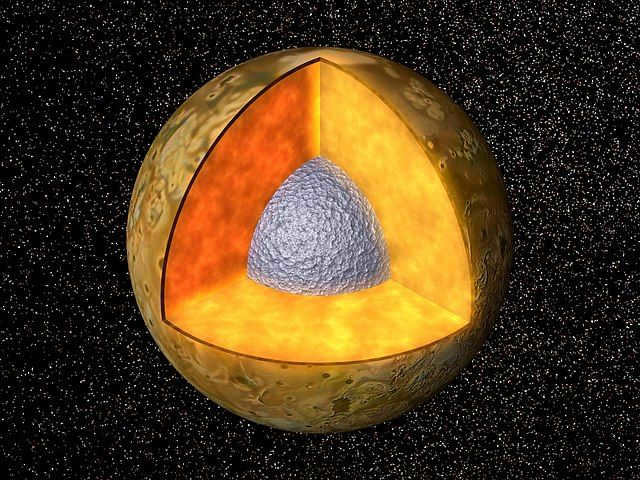
If you examine the satellite images, you will notice pale regions, which are formed by sulfur dioxide, a substance that is consistently found on the planet’s surface. The atmosphere of Io additionally contains sulfur monoxide, atomic sulfur, and oxygen.
Given its volcanic activity, the surface of Io exhibits lava flows, with thousands of active volcanoes dotting the landscape.
The continuous eruptions of these volcanoes have resulted in the formation of numerous craters on Io’s surface, some of which can reach depths of up to 50 km.
Europe
Europe is a frosty moon of Jupiter. It has a surface covered by a 20 to 40 km thick layer of ice, beneath which lies an ocean (approximately 30 km deep), followed by a layer of rocks and an iron core. The moon contains numerous silicate rocks and has a density comparable to that of the Moon.
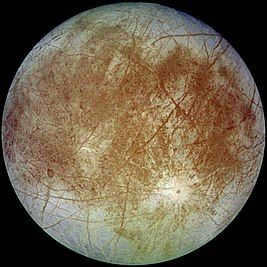
The atmosphere on Europa is highly rarified and consists primarily of molecular oxygen. The satellite’s surface exhibits indications of its youthful age, with a scarcity of craters and a smooth, pristine icy covering. Scientists estimate that Europa Colo is between 30 and 190 million years old.
There is a possibility that some form of microbial culture may exist in the upper layers of Europa’s ocean. To confirm this, it is imperative to measure the salinity and temperature of the ocean. Additionally, life may thrive near the ocean floor due to the presence of hydrothermal vents.
The ocean on Europa contains sufficient oxygen to support the existence of simple organisms such as algae.
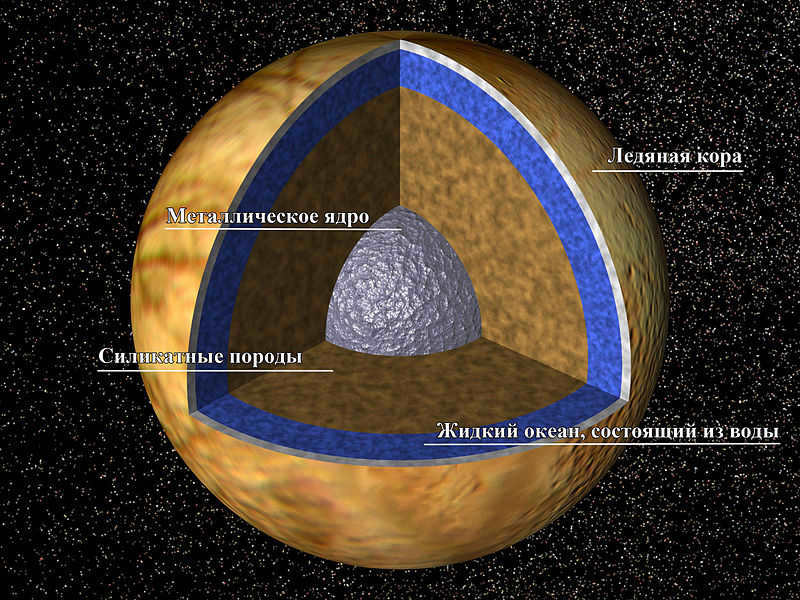
Ganymede
Ganymede, the largest moon of Jupiter, is bigger in size than both Mercury and Pluto. With a diameter of 5,268 kilometers, Ganymede was first discovered in 1610 through the observations made by Galileo Galilei.
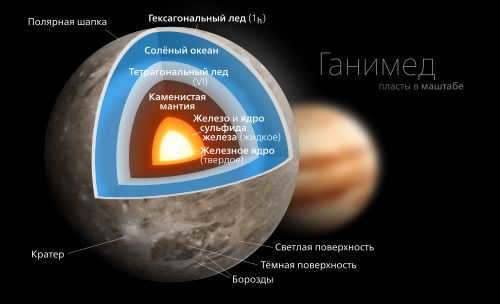
Ganymede, one of Jupiter’s moons, possesses a surface composed of a layer of ice that is 100 kilometers thick. Situated at the core is a mass of iron, which is enveloped by the mantle. The terrain is characterized by craters and intricate formations. It is hypothesized that beneath the substantial ice layer lies a combination of dirt and water.
Despite the identification of an oxygen atmosphere by scientists, the frigid temperatures render Ganymede inhospitable for life.
Callisto
Callisto is one of Jupiter’s moons.
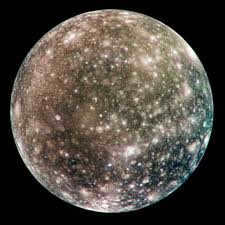
Callisto, a satellite belonging to the Galileo group, was first observed in 1610. Approximately half of Callisto’s composition is ice, while the remaining portion consists of rocky terrain. Beneath the surface lies an icy lithosphere and an ocean. The core is primarily composed of silicates, with a surrounding mixture of rock and ice.
Callisto’s surface is adorned with a greater number of craters compared to any other celestial body in the solar system. There is no activity in terms of tectonic plates or volcanic eruptions.
The atmosphere of Callisto consists mainly of a layer of carbon dioxide, which undergoes constant renewal and typically dissipates completely within a span of four days. Molecular oxygen has not been detected, although it is believed to still be present in the atmosphere.
The presence of an ocean on Callisto instills hope for the potential discovery of extraterrestrial life. There are plans to construct a research base on the satellite in the 2040s.
Additional Moons of Jupiter
Following the initial detection of four moons by Galileo, it took another 300 years before the existence of other satellites around Jupiter became known. In 1892, Almathea was first observed, and throughout the 20th century, additional moons were identified, including Pasiphae, Himalia, Elara, Sinope, Ananke, Lysithea, Karme, Leda, Metis, Adrastei, and Teba.
Since 1999, an additional 49 moons have been discovered, bringing the total number of known satellites orbiting Jupiter to 79. Some of these newly discovered moons have yet to receive official names.
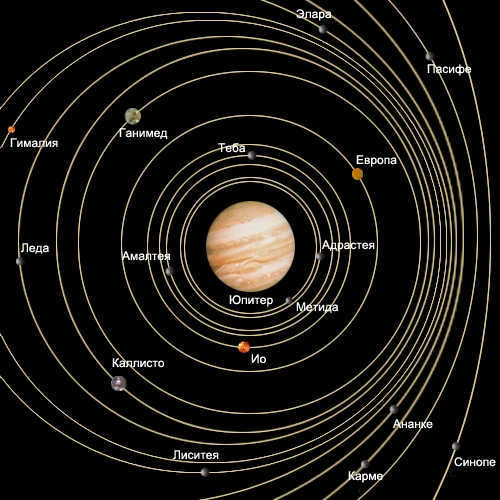
- Inner satellites. Positioned inside Io’s orbit, there are four of them: Almathea, Metida, Thebes, and Adrasteia. Almathea, being the largest, exhibits a non-uniform relief and is dotted with numerous craters. These satellites follow regular orbits, mirroring the motion of the primary satellites.
- Outer satellites. Each satellite within this group possesses unique characteristics, resembling shapeless stone blocks. They traverse elliptical orbits and primarily consist of fragments from larger satellites or planets. Among the outer satellites, both regular and irregular ones exist. Satellites closer to Jupiter align their axes with the motion of the main satellites.
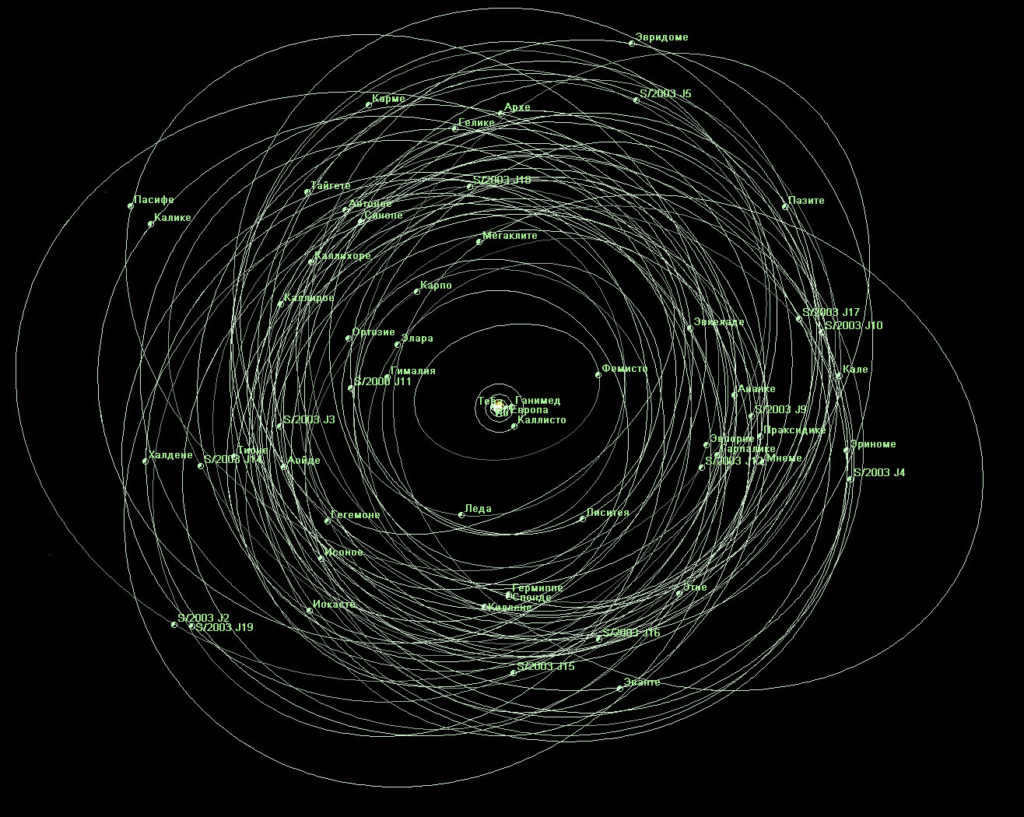
Trojan Asteroids: An Introduction
Dubbed after the legendary warriors of the Trojan War, the Trojan asteroids are two vast clusters of celestial bodies orbiting the Sun. These asteroids are positioned at Lagrangian points L4 – L5.
The first of these asteroids were initially detected in close proximity to the planet Jupiter.
The Trojan asteroids can be classified into the following groups:
- The “Greeks”: Hector, Achilles, Nestor, Odysseus, and many others. These asteroids are located 60 degrees ahead of Jupiter.
- The “Trojans”: Patroclus, Aeneas, Priam, Anchises, Ascanius, and more. These asteroids are situated 60 degrees behind Jupiter.
Asteroids positioned at L4 are referred to as “Trojans,” while those at L5 are known as “Greeks.” In total, there are approximately 1800 “Trojans” and 2800 “Greeks” known to us.
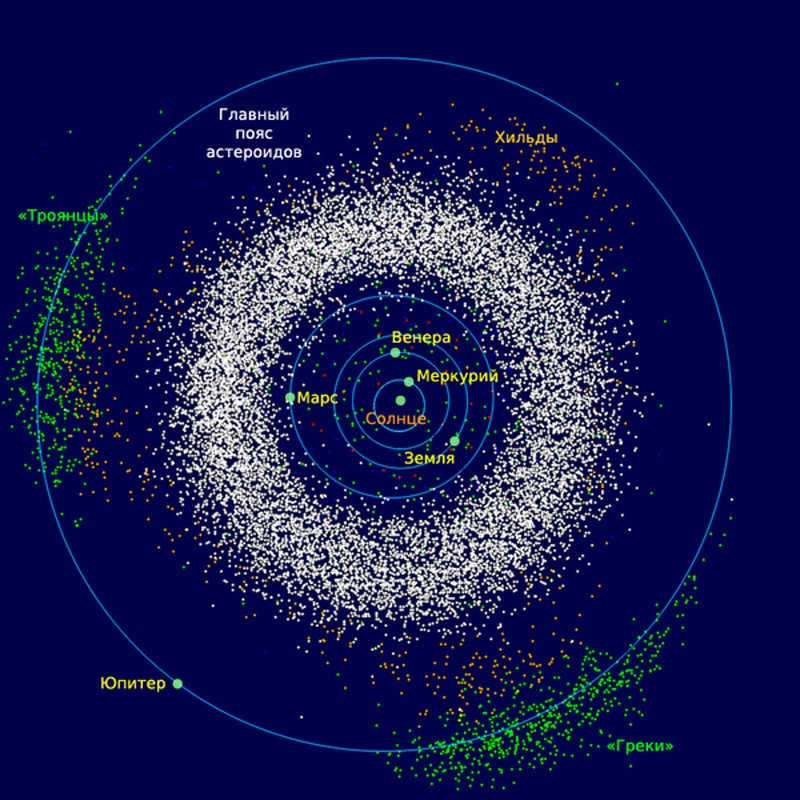
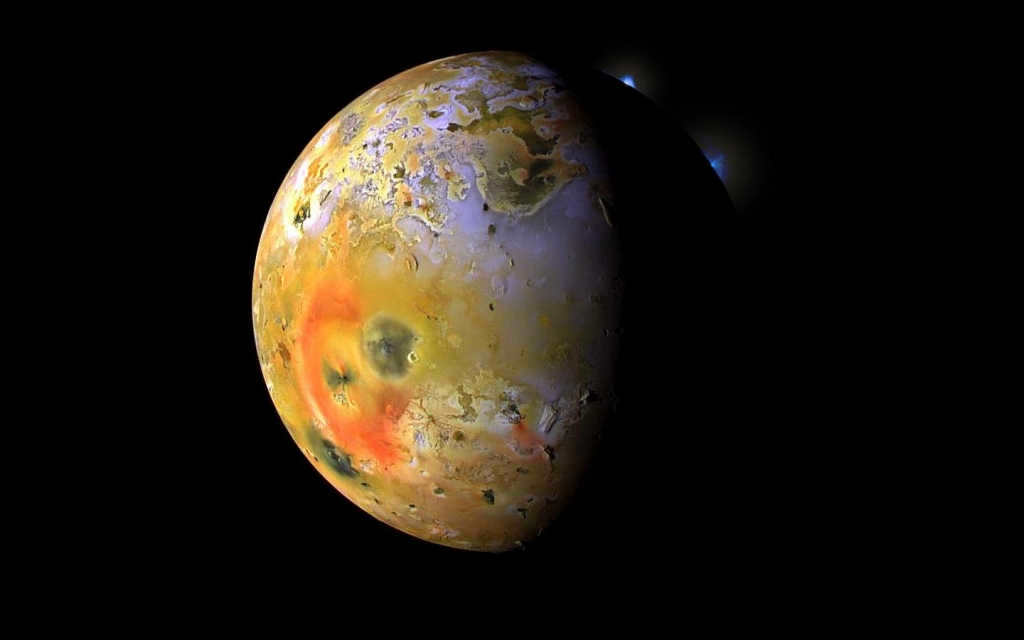
Io is a moon orbiting Jupiter. It has a size of 3,642 kilometers in diameter. The satellite is named after Io, a priestess of Hera in ancient Greek mythology.
Since humans became self-aware, the enigmatic sky has captivated their attention. Initially, it caused astonishment and wonder, as it was perceived as something incomprehensible and thrilling. However, it also brought fear and the potential for misfortune. Eventually, the sky became a source of hope and a subject of study.
Despite humanity’s progress, our knowledge of the universe remains limited. While we have explored our solar system to a significant extent, there are still numerous unsolved mysteries.
Today, we will focus on the satellites of the planets in our solar system, particularly the intriguing moons of Jupiter and the planet itself. Currently, Jupiter has 79 known satellites, with only four of them discovered by the renowned Galileo Galilei. Each of these moons possesses its own unique and fascinating characteristics.
Discovery History
However, the most enigmatic celestial body is Io – it was initially observed by Galileo Galilei in 1610 and designated as Jupiter I. The captivating aspect about this planet is its ongoing volcanic activity, which entices astronomers from Earth. Interestingly, this volcanic activity is extremely intense. Nine active volcanoes situated on Io’s surface forcefully eject substances into the atmosphere, reaching altitudes of 200 kilometers and beyond – a magnitude of power that is truly remarkable. Within our solar system, only two celestial bodies exhibit volcanic activity: Earth and Jupiter’s moon, Io.
What makes the satellite fascinating

Feel free to click on the image to explore an interactive representation of Io.
However, Io is not only renowned for its volcanoes, but also for its unique geological features resulting from the combination of radioactive activity and electric currents within its interior. These powerful currents are generated by the satellite’s substantial magnetic field and the intense tides caused by Jupiter’s gravitational pull.
The planet’s overall appearance is breathtaking, with its vibrant mosaic of red, yellow, and brown hues. Similar to the Moon, Io always keeps the same side facing Jupiter. The average radius of this celestial body measures 1,821.3 kilometers.
On January 7, 1610, Galileo Galilei made a remarkable observation of Io using the very first refractor telescope in the world. Initially, the renowned astronomer mistakenly identified the satellite as part of Europa. However, on the following day, he carefully scrutinized the satellites individually and corrected his initial assessment. As a result, January 8, 1610 is widely acknowledged as the official date of Io’s discovery.
Significant research on Io
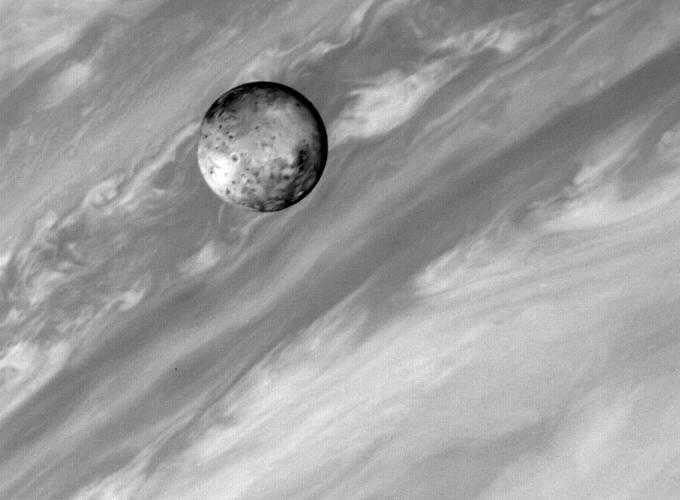

This is a picture taken by the Voyager 1 spacecraft showing Jupiter and its moon Io.
On December 7, 1995, Galileo made a close flyby of Io, capturing numerous images of its surface and uncovering the presence of an iron core. Sadly, the Galileo mission came to an end on September 23, 2003, when the spacecraft was deliberately burned up in Jupiter’s atmosphere. Prior to its demise, Galileo transmitted back to Earth awe-inspiring photographs of the moon, showcasing breathtaking views taken from a mere 261 kilometers above its surface.
The appearance of the moon Io
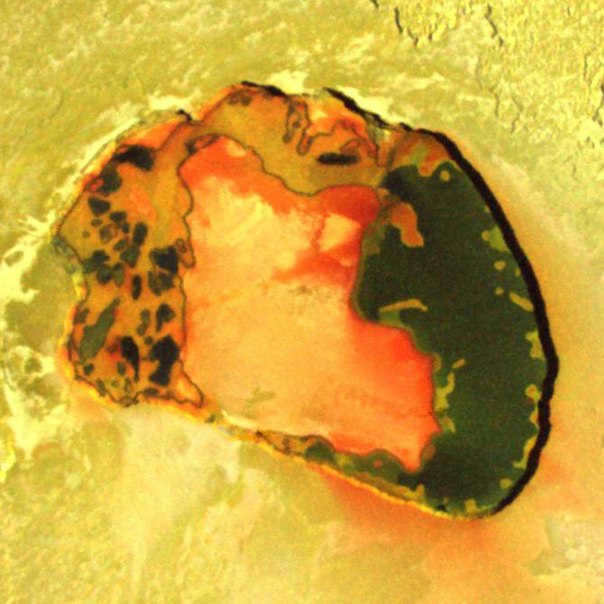

Extraordinary hues can be observed within the volcanic crater Patera on the moon Io, which orbits around the planet Jupiter. This captivating image was captured by NASA’s Galileo spacecraft.
The atmosphere of Io satellite
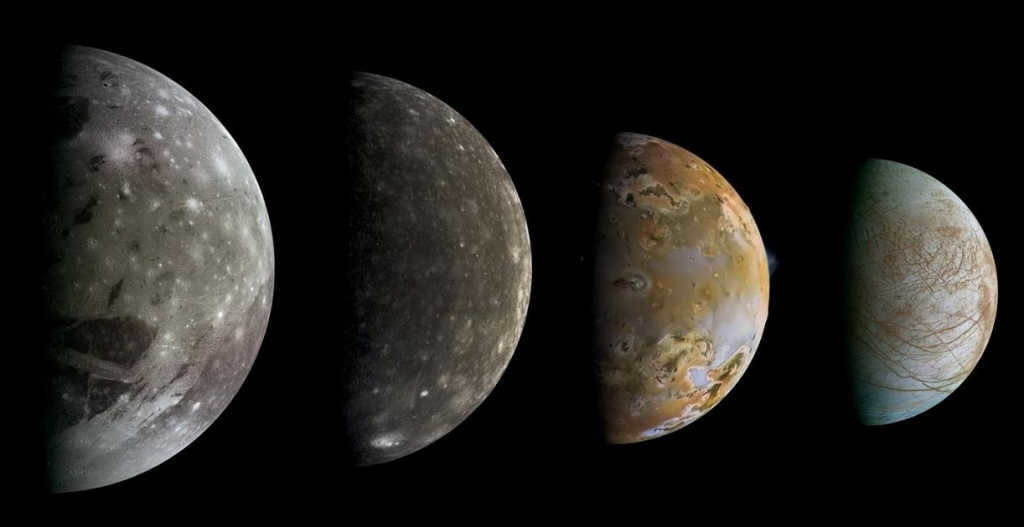
Ganymede, Callisto, Io and Europa
The satellite possesses a thin and low-density atmosphere, or more accurately, an exosphere that is filled with volcanic gases. These gases include sulfur dioxide and other compounds. However, unlike the other satellites of Jupiter, Io’s volcanic emissions do not contain water or water vapor.
An important discovery made by the Galileo spacecraft was the identification of an ionosphere at a significant altitude of the satellite. The volcanic activity on Io significantly affects its atmosphere and ionosphere.
The satellite’s orbit and rotation
Io is a synchronous satellite that orbits Jupiter at a distance of 421700 km from its center. It takes 42.5 hours for Io to complete one full revolution around the planet.
Volcanic activity on Io
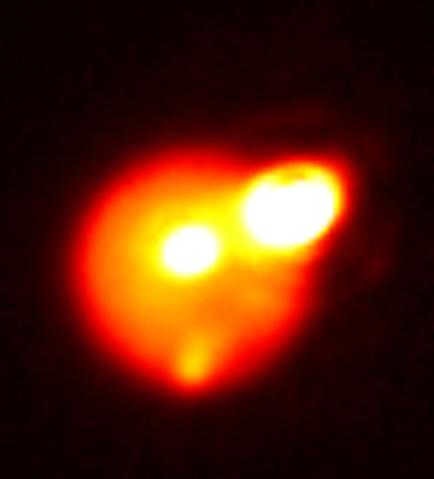
There have been three significant volcanic eruptions.
The eruption phenomena observed on the satellite are not caused by the radioactive decay of elements, but rather by the influence of Jupiter’s tidal interaction. The tidal energy warms up the interior of the satellite, resulting in the release of an enormous amount of energy, estimated to be around 60 to 80 trillion watts, which is not evenly distributed. For instance, the Voyager-1 spacecraft detected a total of 8 active volcanic eruptions. Subsequently, the Voyager-2 spacecraft surveyed the surface and observed 7 ongoing eruptions.
Io is an astonishing and extraordinary planet, unlike any other in our entire solar system. The immense volcanic activity on this moon, comparable in size to our own Moon, is truly mind-blowing. The futuristic images captured by numerous spacecrafts of Io’s surface are so captivating that they transport you to the atmosphere of this remote and enigmatic world over and over again.
Europa, discovered by Galileo Galilei in 1610, is one of the four satellites of Jupiter. It was the first satellite to be observed using a telescope, making it a significant discovery in the history of astronomy. Even with a weak telescope, Galileo was able to spot Europa, along with three other satellites of Jupiter. In the hierarchy of Jupiter’s satellites, Europa is the sixth one.
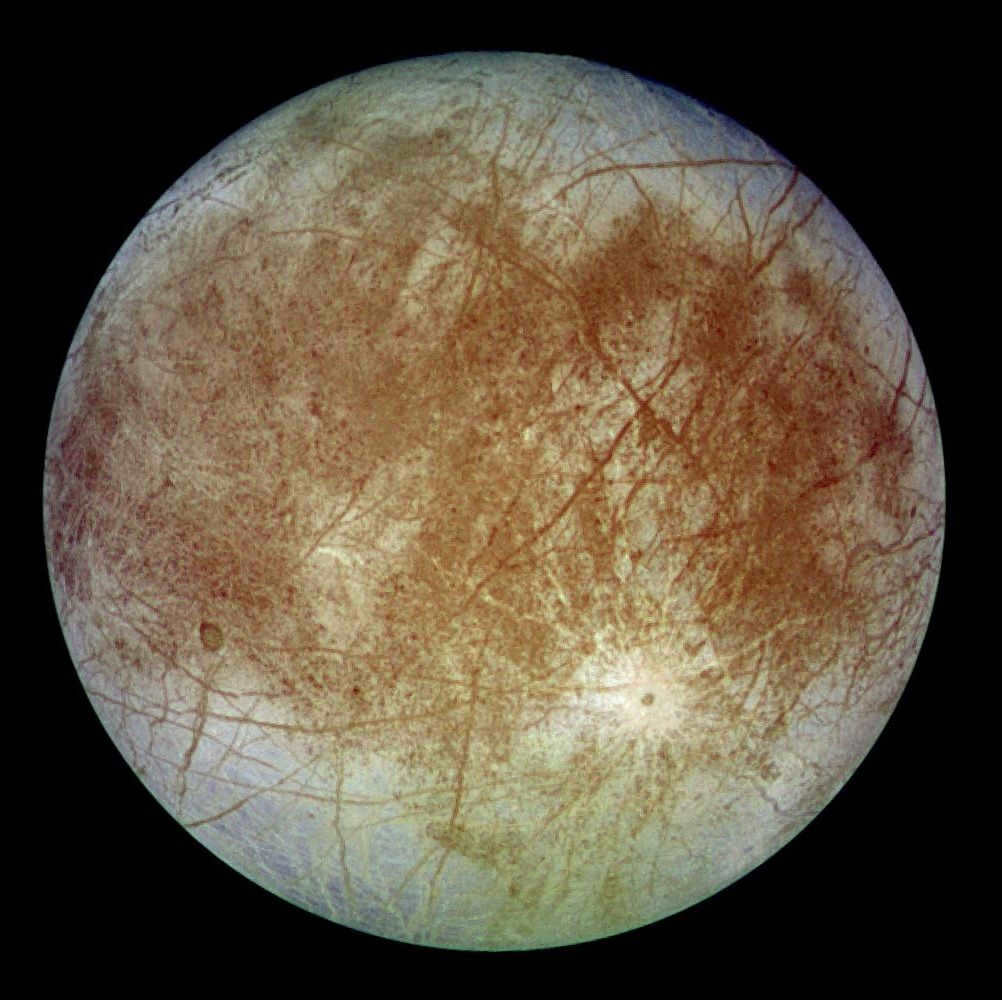
The satellite of Jupiter known as Europa – is the smallest of Jupiter’s Galilean satellites. Despite being small, it is comparable in size to the Moon and ranks among the largest satellites of any planet in the solar system. It was designated by Galileo as “the second satellite of Jupiter.”
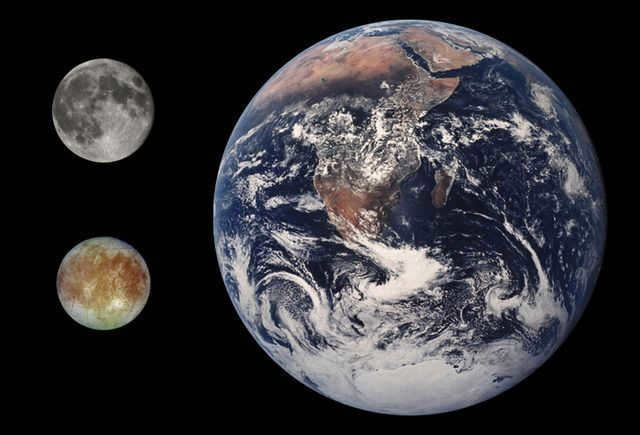
Due to the tidal forces exerted by Jupiter, Europa’s rotational speed has significantly decreased, resulting in its rotation period around its axis being equal to its rotation period around the planet. Similar to our Moon, one side of Europa always faces Jupiter.
An unfavorable aspect of Europa is that its orbit is situated within Jupiter’s intense radiation belt. Consequently, the colonization of this Jupiter moon will require considerable patience.
| Europa, one of Jupiter’s satellites – has certain physical characteristics: Its diameter is 3138 km. It has a mass of 4.8 x 10 22 kg. The density of Europa is 3.01 g/cm 3. Its acceleration of free fall is 1.314 m/s 2. Europa’s period of rotation around its axis is the same as its period of orbit around Jupiter. Its albedo is 0.67 | Europa, one of Jupiter’s satellites – has specific orbital characteristics: Its orbital period is 3.551181 days. The orbital inclination to the equator of Jupiter is 0.47° The eccentricity of Europa’s orbit is 0.009. |
Europa’s Satellite Structure: An Overview
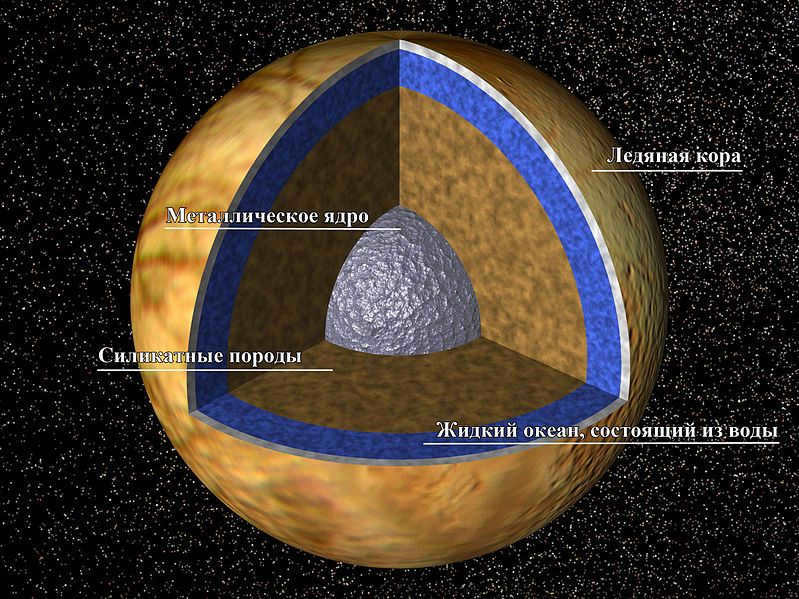

The composition of Jupiter’s moon Europa has been determined using indirect information. At its core, there is a small metallic center, which is surrounded by rocks, most likely made of silicates. The surface of Europa is covered by a layer of ice that is estimated to be around 10-30 kilometers thick. Beneath this icy layer, there is believed to be approximately 90 kilometers of water. If these calculations are accurate, the amount of water on Europa exceeds the volume of Earth’s oceans!
An expanse of liquid water found on Europa
The moon of Jupiter, known as Europa, possesses its own magnetic field, which has sparked much speculation. It is believed that this magnetic field is likely generated by electric currents within a water ocean that lies beneath an icy surface. The strength of the field suggests that it is more probable to be formed by the water ocean rather than a small metallic core. Magma layers are unlikely to exist on small celestial bodies like Europa, leaving liquid water as the most plausible explanation.
Furthermore, the power and orientation of Europa’s magnetic field changes depending on the moon’s position relative to Jupiter, indicating that it is created by conductive liquid. However, there is a suggestion that a layer of soft ice may also play a role in the formation of the magnetic field.
Europa is particularly intriguing because it raises the question of how a subglacial ocean of liquid water could have formed beneath its surface. It is believed that similar water oceans may exist on other moons, but on those moons, the water would be in a liquid state at depths of several hundred kilometers due to the immense pressure exerted by the ice shell above. However, on Europa, the ice shell is too thin to generate such pressure.
One theory suggests that the heating of water on Europa may be caused by the tidal forces exerted by Jupiter. During tidal events, the surface of Europa can rise up to 30 meters, resulting in a significant amount of energy being converted into heat, which can then melt the ice in the deeper layers of the moon. The surface layer of ice acts as an insulator, while the surface itself remains extremely cold by Earth’s standards, reaching temperatures as low as -170°C.
If this assumption is accurate, then it appears that a planet does not need to be situated near a hot star in order for liquid warm water to exist. Instead, it only requires the presence of sufficiently strong tidal forces within the system of mutual attraction between two celestial bodies.
In 2012, the Hubble Space Telescope captured images of what seemed to be a water eruption near Europa’s South Pole, although the available data was insufficient to make a definitive conclusion.
In 2016, new photographs were obtained, confirming that these were indeed geysers expelling liquid water, similar to the famous geysers on Enceladus. Watch a news report about the geysers on Jupiter’s moon Europa:
Life on Europa, Jupiter’s Moon
Europa, one of Jupiter’s moons, is a promising candidate in the search for alien life. The presence of liquid water is crucial for the development of Earth-like protein-based lifeforms.
If the hypothesis of an ocean of liquid water on Europa is accurate, it suggests that a planet doesn’t necessarily have to be located near a hot star to sustain liquid water. Instead, strong tidal forces between two celestial bodies can generate enough heat to prevent the water from freezing.
And then things take an unexpected turn.
Since the presence of liquid water does not require the radiation of a star, the search for protein-based life can extend beyond star systems and include the outer regions of stellar systems, including our own Solar System.
Life may exist in close proximity to extremely small stars.
Furthermore, it is possible that life exists in planetary systems that lack the necessary mass to ignite a central star, making them invisible to our current observations!
Indeed, the possibility of subglacial life in the absence of light exists. On our planet, various ecosystems thrive in complete darkness, such as underground lakes, caves that have been isolated from the external environment for thousands of years, and ecosystems near volcanic “black smokers” at the ocean floor. This is why the exploration of Jupiter’s moon Europa has garnered significant attention. It is crucial to conduct research and gather evidence to support the hypothesis of a liquid water ocean on Europa.
Investigation of Europa, Jupiter’s Moon
The satellite Europa has been the subject of continuous research conducted by NASA’s interplanetary missions. In December 1973, the spacecraft “Pioneer-10” captured images of Europa, while in 1979, the “Voyager 1 and Voyager 2” missions provided even more detailed photographs of its surface. These missions also gathered data that suggested the presence of a liquid ocean on Europa, further enhancing our understanding of Jupiter’s moon.
Presently, both NASA and the European Space Agency (ESA) are collaborating on various programs aimed at exploring Jupiter’s moon, Europa. One such initiative is the ESA’s “Laplace” project, which has invited participation from Russian space enterprises and institutes. These joint efforts are expected to yield more accurate measurements and valuable insights into Europa’s unique characteristics.

Europa, which was discovered by Galileo Galilei, is one of the four moons of Jupiter. It is the smallest moon among the Galilean group and is positioned sixth in terms of distance from the planet.
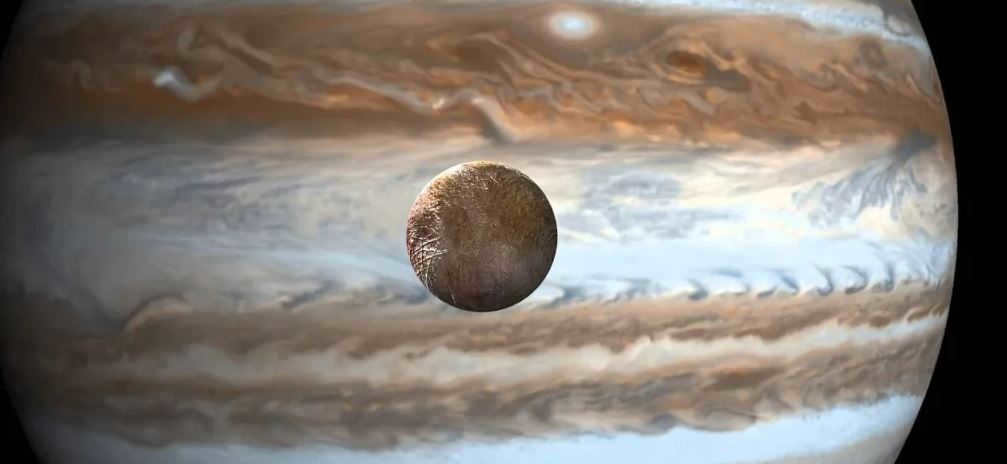
The moon is characterized by having an icy surface and a warm, salty ocean beneath it, making it an ideal candidate for the search for extraterrestrial life.
Discovery History
Europa was first observed by the Italian scientist Galileo Galilei in January 1610. Using an improved telescope, he noticed bright spots surrounding Jupiter, initially mistaking them for reflections of stars. However, he soon realized that they were actually satellites of the planet.
Galileo Galilei chose a different approach and assigned Roman numerals to Jupiter’s satellites. The name suggested by Simon Marius did not see much use and only gained recognition and official status in the 20th century. The finding of Almathea in 1892 caused Europa to be shifted to the third position among Jupiter’s satellites, and the discovery of Voyager in 1979 pushed it further down to the sixth spot.
Characteristics of the body
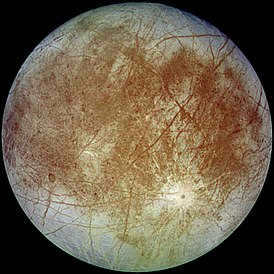

Europa, one of Jupiter’s satellites, has an equatorial diameter of 3.1 thousand kilometers. This makes it 10% smaller than Earth’s Moon. If Europa were to replace the Moon, the difference would not be noticeable from the surface of our planet. The only noticeable change would be that Europa would appear much brighter due to the high reflectivity of its icy shell.
Europa’s orbit is approximately 671,000 kilometers away from Jupiter. It takes 45 minutes for sunlight to reach Europa. However, due to the significant distance between Europa and the Sun, the sunlight on Europa is 25 times fainter than on Earth.
Orbit and rotation
Europa orbits Jupiter in 3.55 days, completing a full revolution. Similar to the other moons in the Galilean group, Europa is gravitationally locked and always shows the same side to the main planet. Scientists have observed a resonance between Europa and two other moons, Io (2:1) and Ganymede (4:1). The gravitational influence of Io and Ganymede causes oscillations and tidal effects on Europa.
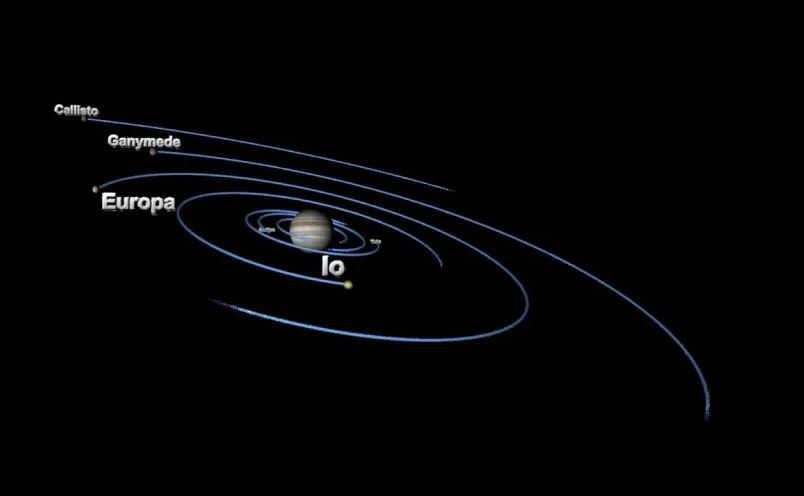
The cracking of Europa’s ice shell is caused by tidal forces. In the event of a liquid ocean existing beneath the ice shell, the heating during tides can initiate hydrothermal or volcanic activity on the seafloor. As a result, nutrients would be produced, making the ocean capable of supporting life.
The ice shell of Europa
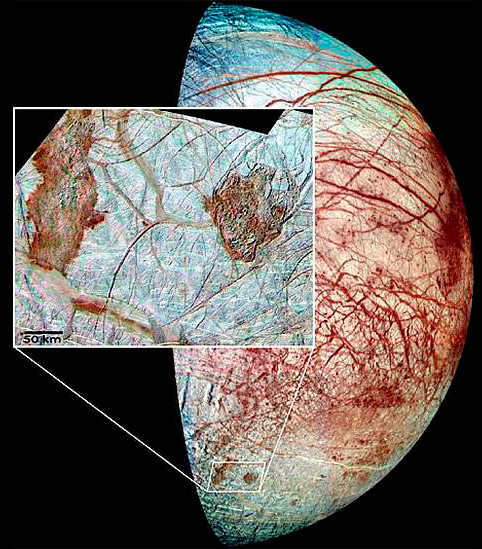

Scientists have approximated that Europa’s outer layer was formed relatively recently, around 20-180 million years ago. It consists of a white and smooth ice crust, with occasional craters and hills.
The pristine surface is adorned with a intricate network of fractures. These cracks take on a reddish hue due to the presence of salts, sulfur, and iron compounds. The temperature on Europa’s surface reaches as low as -150 °C near the equator and drops to -220 °C at the poles.
One notable characteristic of Europa is the existence of dark concave or convex spots on the icy shell, which have been nicknamed “freckles”.
Scientists speculate that these structures formed due to the upward movement of warmer ice from lower layers, resembling the motion in a lava lamp. These freckles have a diameter of up to 10 kilometers.
The radiation level on Europa is incredibly high – measuring 5400 m3 per day. It possesses the potential to exterminate any form of life.
Scientists propose that a genuine liquid ocean lies beneath the icy surface of Europe.
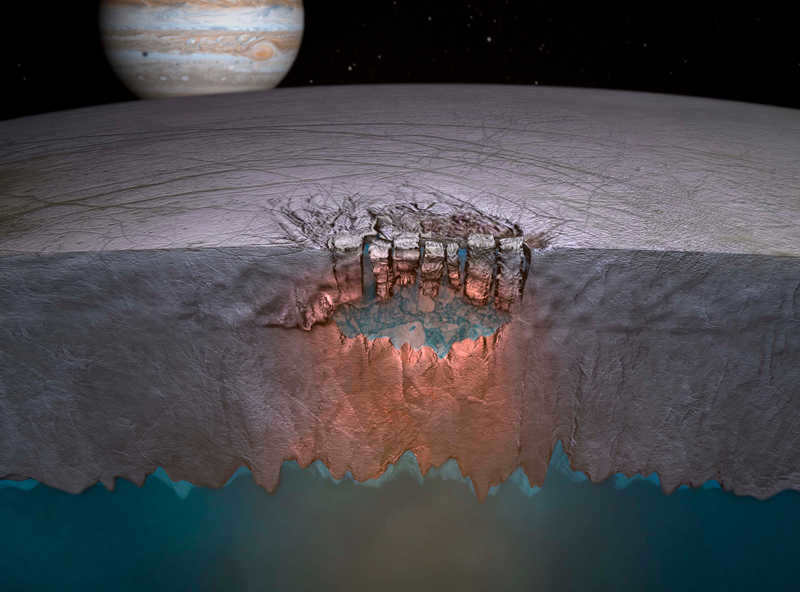

There are several indications pointing to the presence of an ocean beneath Europa’s icy shell:
- The magnetic field on the satellite, as recorded by the “Galileo” instrument, shows unusual fluctuations.
- Periodically, water geysers erupt from beneath Europa’s ice crust, reaching heights of 200 kilometers, which is twenty times higher than Mount Everest.
- Scientists have observed “freckles” on the ice crust, which they believe are caused by the movement of ice within the water column.
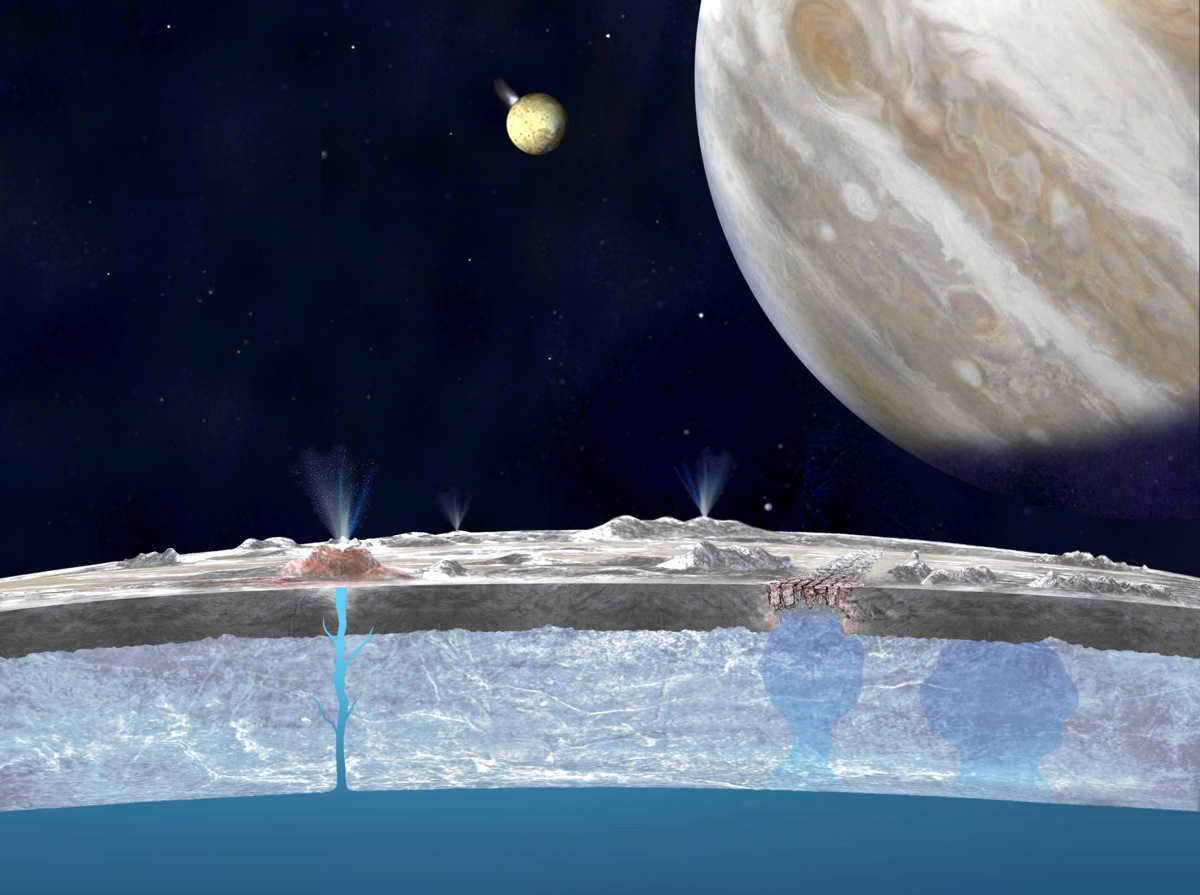
If the theory of a liquid ocean is accurate, Europa can be described as having the following composition:
- a 10-30 km thick layer of ice;
- a 20-30 km deep liquid ocean;
- a substantial rock layer;
- a metallic core.
According to scientists, the subglacial ocean on Europa is estimated to contain a volume of 3×1018 m3, which is twice the amount of all the water resources on Earth.
Europa possesses a feeble atmospheric layer composed of molecular oxygen, with a pressure measuring at 0.1 µPa. Researchers hypothesize that the oxygen is not of biological nature, but rather generated through the influence of ultraviolet radiation, which interacts with the ice crust, causing the separation of water into hydrogen and oxygen.
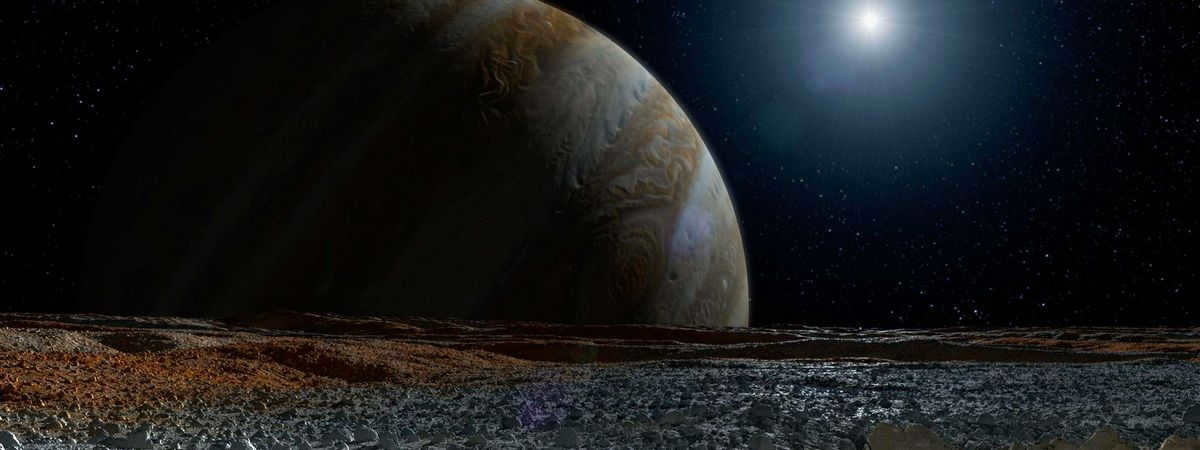
Europa, one of Jupiter’s satellites, is believed to have a unique environment that may support life. The gravitational forces on Europa cause a portion of the molecular oxygen to remain on its surface. This oxygen can then seep through cracks in the icy shell and reach the water surface, potentially triggering biological processes. Additionally, a significant amount of hydrogen rises up from Europa’s interior, forming a cloud. The atoms in this cloud become ionized and create a source of planetary magnetospheric plasma.
Exploration
Since 1973, there have been a total of ten missions dedicated to researching Jupiter, with eight flyby missions and two orbital missions. These missions have captured images of not just Jupiter itself, but also its various satellites, including the fascinating Europa.
Focusing on the exploration of Europa:
| Year | Aircraft |
| 1973 | “Pioneer 10” |
| 1974 | “Pioneer 11” |
| 1979 | “Voyager 1” |
| 1979 | “Voyager 2” |
| 1992 | “Ulysses” |
| 1995-2003 | “Galileo” |
| 2000 | “Cassini” |
| 2004 | “Ulysses” |
| 2007 | “New Horizons” |
| 2016-present | “Juno” |
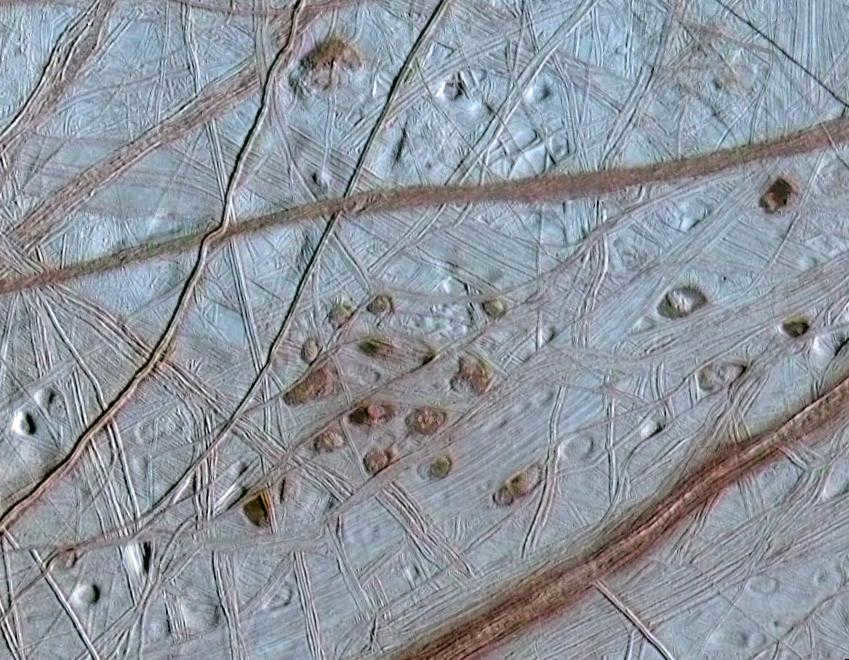
In 2024, NASA has scheduled a mission to Europa called the Europa Clipper. The main objectives of this mission are:
- to gather precise data on the ice crust;
- to examine the surface and topographical features of the moon;
- to detect any signs of water vapor that could be emanating from beneath the ice crust.
The spacecraft will be launched into space using the SLS launch vehicle. The journey to Europa will take approximately 7 years, followed by a 109-day primary scientific program.
Habitability
There is a hypothesis among scientists that Europa’s subglacial ocean or hydrothermal vents may have the potential to support life. It is believed that microbial organisms might thrive on the ocean floor, particularly in proximity to hydrothermal vents. Additionally, it is speculated that primitive life forms could potentially evolve beneath the icy surface and adhere to it, much like algae.
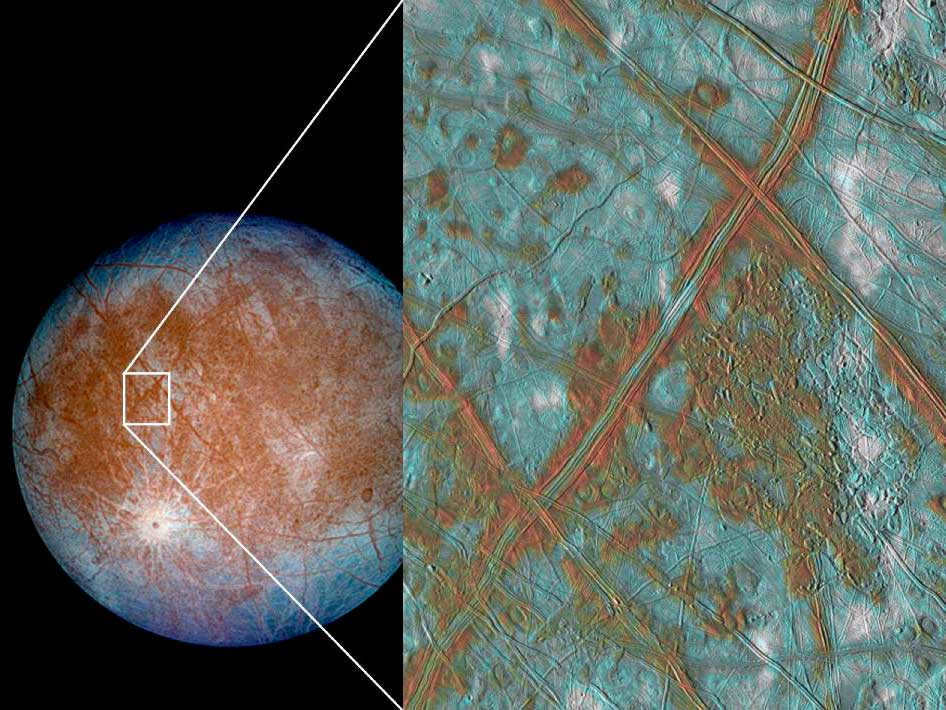
Professor R. Greenberg from the University of Arizona has conducted extensive calculations and has reached the conclusion that Europe’s ocean is fully saturated with oxygen, providing enough conditions for the emergence and growth of certain life forms. Additionally, it is possible that some microorganisms could have arrived on the moon through meteorites.
Biologists have emphasized that the presence of life on Europa is dependent on the salinity of the subglacial ocean. Cold and excessively salty water significantly diminishes the likelihood of discovering any life forms in this environment.
In 2013, scientists discovered the presence of hydrogen peroxide on Europa. This substance has the potential to serve as an energy source for various bacteria. Furthermore, traces of clay minerals with a cometary or asteroidal origin (phyllosilicates) were also detected. The existence of phyllosilicates substantially enhances the chances for the emergence and growth of life on Europa.
Strategies for Establishing New Settlements

Explorers with bold ambitions are formulating plans to establish a settlement on Europa. The subglacial ocean will serve as a valuable resource for the colonizers, providing them with both air and rocket fuel. By employing various techniques such as rocket attacks, the temperatures can be elevated, causing the ice to melt and filling the atmosphere with oxygen.
However, one significant obstacle hindering the colonization of Europa is the elevated levels of radiation, which pose a serious threat to human life. Exposure to such high doses of radiation can prove fatal within a single day. Hence, the colony must be positioned beneath the protective ice shell of Europa.
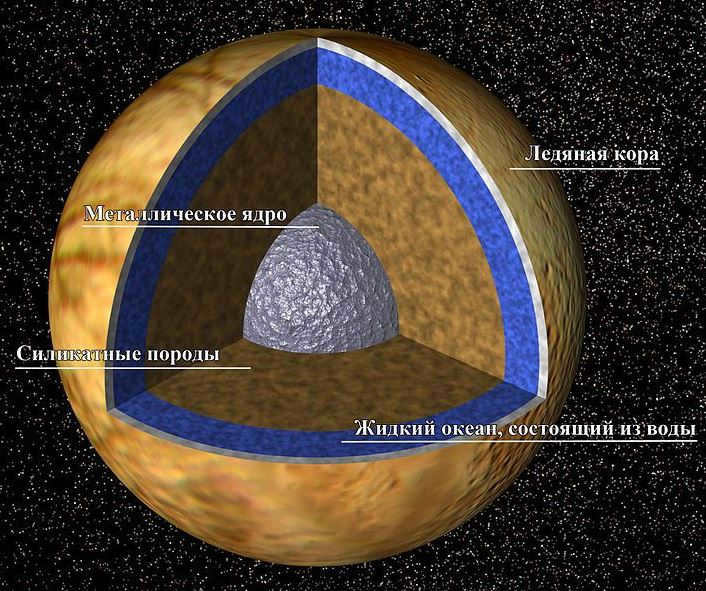
The gravity on Europa is relatively low, resulting in physical discomfort, weakness, gradual muscle atrophy, and bone deterioration for the crew.
In order to combat these physical weaknesses and bone degradation, the ISS has developed a specialized exercise regimen.
There is a possibility that living organisms may exist on Europa, and if so, the arrival of humans and terrestrial microbes could have disastrous consequences for both the moon and its inhabitants.
Currently, scientists are only planning to colonize Europa, but in the future, humans may follow the probes as this satellite possesses valuable resources and the necessary conditions for life to thrive and evolve.
Answering the questions
Most probably, the trophic chain will rely on chemotrophic bacteria as its foundation. These bacteria will create layers of organic sediments on the ocean floor and serve as a source of food for herbivorous organisms. Consequently, there will also be predatory organisms resembling sharks in the ocean.
The aircraft will transport a specialized module to Europa and lower it beneath the icy surface. The floating rover will be able to attach itself to the lower edge of the ice shell and travel along it, gathering the necessary scientific data. This rover has already been prepared for deployment and was successfully tested in Alaska in 2019.
The ocean’s heating can occur due to underwater volcanic activity or the gravitational effects of a gas giant’s moon. In the latter case, the moon’s mantle gets heated, and this heat is transferred to the benthic layers of the ocean.
A scientific facts video review

Io is known as the most peculiar and enigmatic moon of Jupiter. It experiences daily eruptions of hundreds of volcanoes, sulfur snowfall, mesmerizing auroras, and emits a peculiar odor reminiscent of rotten eggs. Additionally, the surface temperature of Io varies dramatically, ranging from -183°C to 1527°C.
The Satellite’s Discovery
The credit for discovering Io goes to the Italian scientist Galileo Galilei. In 1610, using his homemade telescope with a 20x magnification, he spotted Jupiter’s four satellites. Initially, Galileo thought Europa and Io were a single entity, only realizing they were separate celestial bodies on the second day after the discovery.
Io has earned various monikers, including “Hell’s furnace,” “Cosmic hell,” “Volcanic underworld,” and “Boiling cauldron.” These names allude to the moon’s unfavorable characteristics.
Mass and dimensions
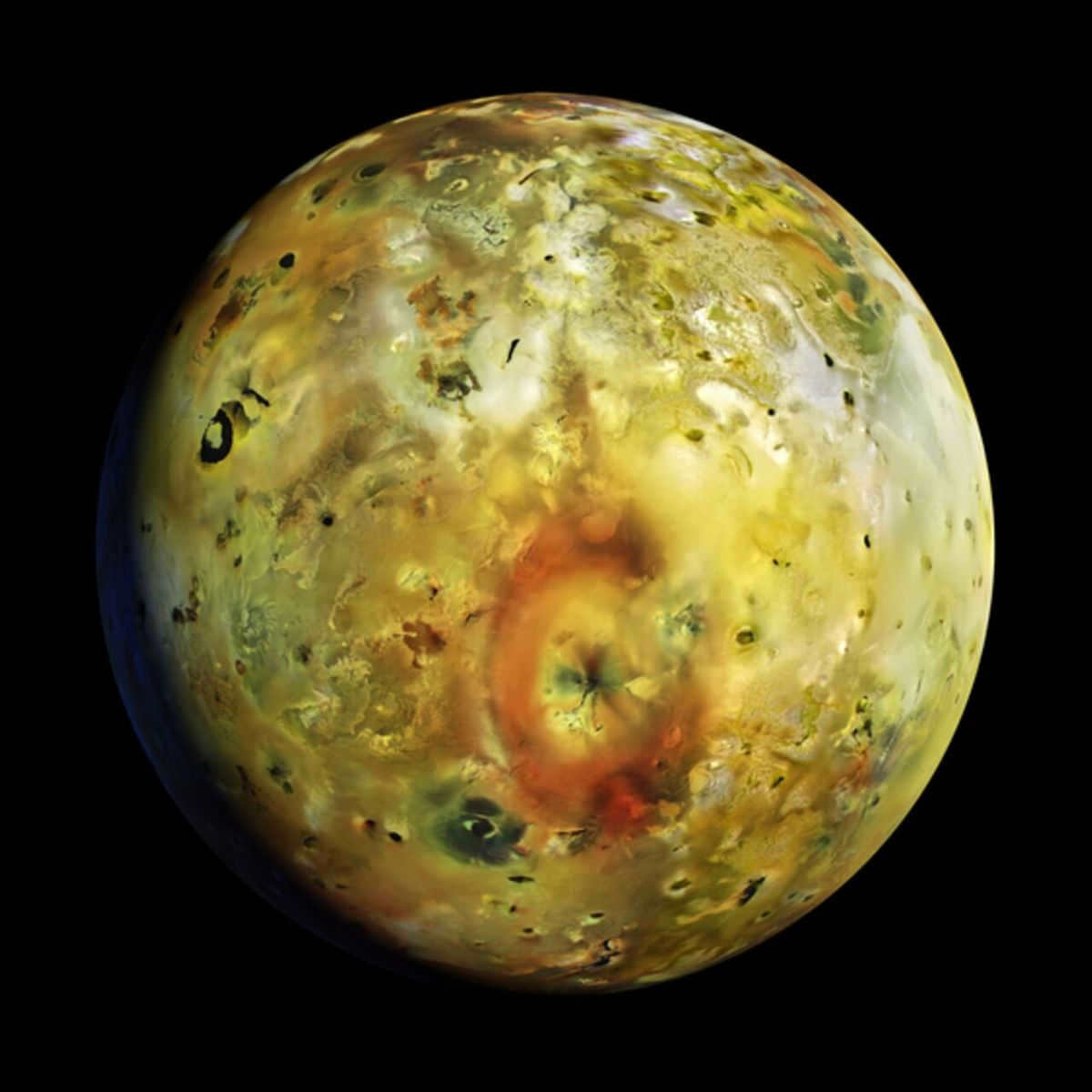
The shadow of Io on Jupiter
To visualize the mass and size of Io, let’s compare Jupiter’s moon to Earth.
Comparison of Io and Earth:
| Indicators | Io | Earth |
| Radius, km | 1821 | 6371 |
| Mass, kg | 8.93×10²² | 5.97×10²⁴ |
| Difference between polar and equatorial poles, km | 25 | 14.2 |
Based on the data provided in the table, it can be inferred that Io is approximately 3.5 times smaller and 67 times lighter than Earth. Both celestial bodies possess a spherical shape, although Io is slightly more flattened at the poles. Specifically, the polar diameter of Io is 14.2 km less than its equatorial diameter, whereas Earth exhibits a greater difference of 25 km between these measurements. In other words, Io is more oblate at its poles compared to Earth.
Orbit
Rephrase the text, making it unique, using the English language and preserving the HTML markup:
Orbit is a spaceflight simulator game that allows players to experience what it’s like to be an astronaut. In the game, players can explore the solar system, visit different planets and moons, and even build their own space stations. The game features realistic physics and graphics, making it a truly immersive experience. Whether you’re a space enthusiast or just curious about what it’s like to be in space, Orbit is the perfect game for you. So strap on your virtual spacesuit and get ready to embark on an interstellar adventure!
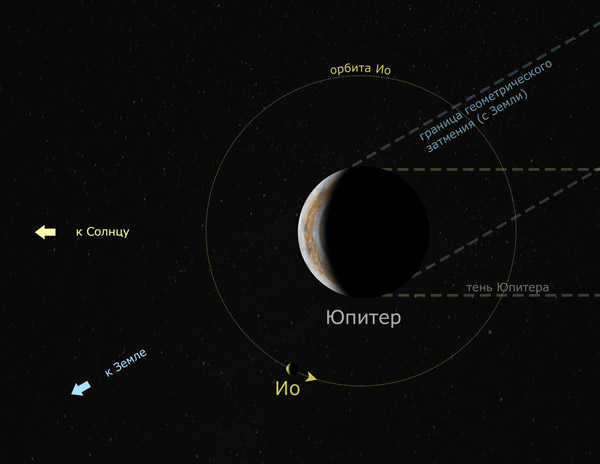
On average, Io is situated at a distance of 426.7 thousand kilometers from Jupiter. Nevertheless, due to its elliptical orbit, the satellite alternately approaches the planet at a distance of 421 thousand kilometers and moves away from it at a distance of 432.4 thousand kilometers.
Io revolves around Jupiter with a velocity of 17.3 kilometers per second. It completes one full orbit around the planet in 42.5 hours. During its continuous movement, the satellite always keeps the same side facing the planet.
Io and other satellites: a comparison
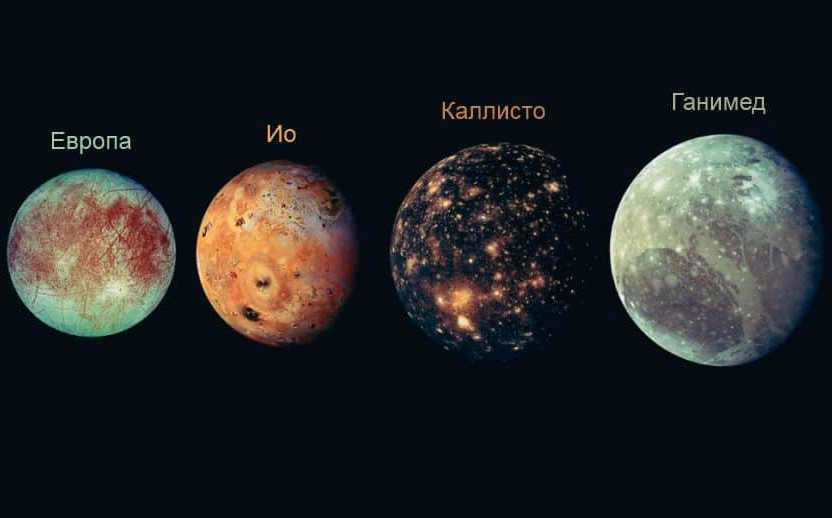
Researchers have made an incredible revelation that Jupiter is accompanied by a staggering 79 moons. Among these, the most prominent ones are Io, Europa, Ganymede, and Callisto, all of which were first observed by Galileo.
Io compared to other moons of Jupiter discovered by Galileo:
As it can be observed, Io is the third largest moon among Jupiter’s Galilean moons, ranking third in terms of mass and first in terms of density. In contrast to the other celestial bodies in the solar system, which are composed mainly of water ice, Io is comprised of a core made of molten iron or iron sulfide, surrounded by silicate rocks.
Composition
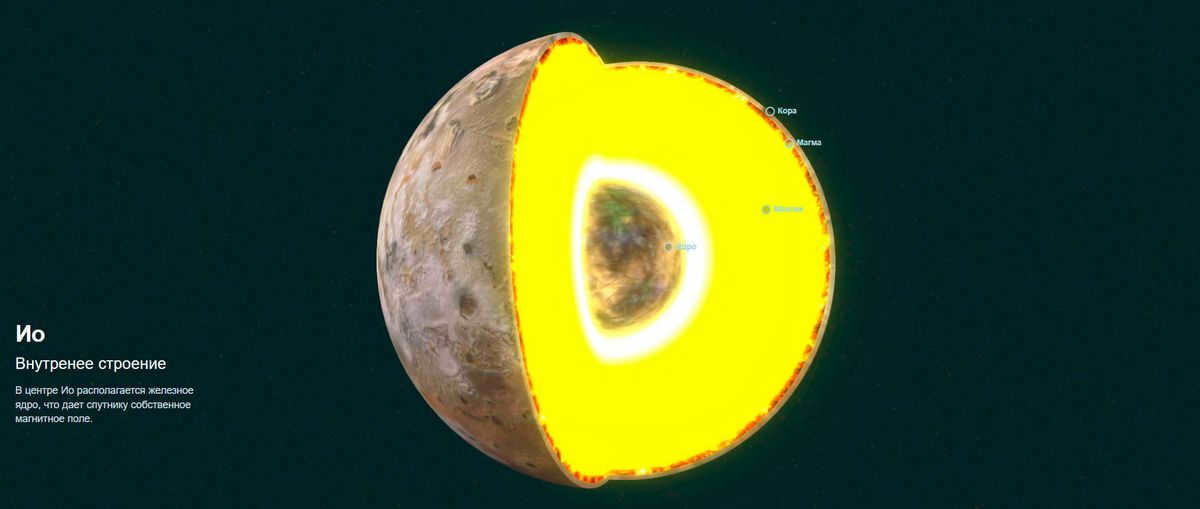
Io is made up of different layers, including crust, magma, mantle, and core. The crust of this celestial object is estimated to be around 30-50 km deep and is primarily composed of sulfur and basalt. The surface of the crust, particularly near the volcanoes, is covered in vibrant lakes of molten lava. On the darker side of the moon, there are extensive plains made of frozen sulfur dioxide or regular sulfur.
The color of the lakes and plains is determined by their chemical composition.
The color of Io’s surface is influenced by various chemical substances, including:
| Surface color | Predominant chemicals |
| Yellow | Pure sulfur |
| Greenish | Pure sulfur |
| White | Sulphur oxides |
| Gray | Sulphur oxides |
| Red | Sulphur exposed to radiation |
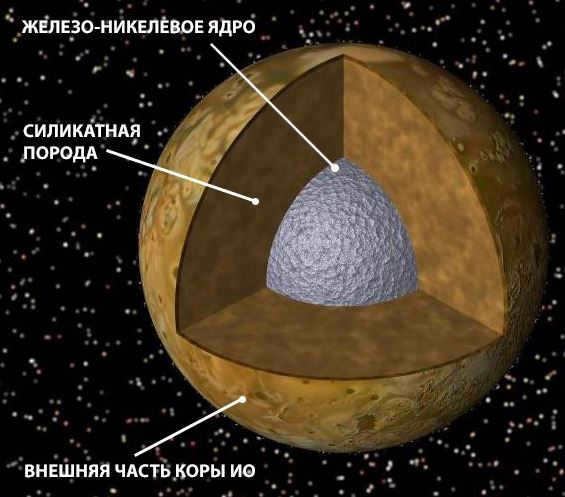

Underneath Io’s surface lies vast oceans of gelatinous molten magma, serving as the fuel for its explosive volcanoes. This layer spans a thickness of 50 kilometers.
Beneath the magma oceans is the mantle, a vast expanse of liquid or partially liquid magma. Comprised mostly of magnesium and iron, the mantle accounts for 75% of Io’s composition.
In the heart of Io resides a solid core, which makes up 20% of the moon’s total mass. Scientists speculate that if the core is dominated by sulfur, it would have a radius ranging from 550 to 900 kilometers, whereas an iron-dominated core would have a radius between 350 and 650 kilometers.
Io possesses a tenuous and feeble atmospheric layer saturated with volcanic gases. The constituents of its makeup encompass:
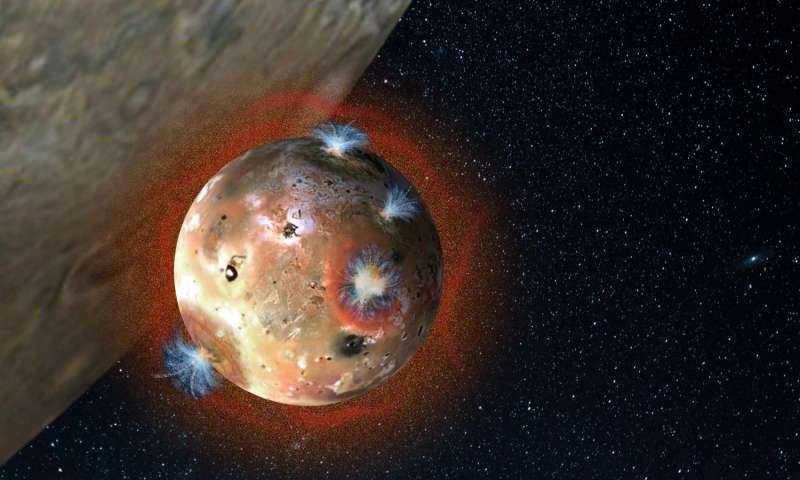
Approximately 100 kg of sulfur dioxide is emitted from the planet’s interior through volcanoes every second. A notable portion of this compound stays in close proximity to the surface of the celestial object, while the remainder enters the atmosphere.
The atmospheric pressure on Io is relatively low, and on the nocturnal side, it can be hundreds of times lower compared to the illuminated side.
Temperature
The satellite possesses the most extensive range of temperatures among all satellites in the solar system. Regions with volcanic eruptions experience extreme heat. A temperature peak of 1527 °C has been documented in these areas. Close to the volcanoes, there are lakes of molten lava that spatter. In contrast, the average temperature away from the volcanoes ranges between -163 to -183 °С. In these regions, thick snow covers the ground.
Mighty outbursts
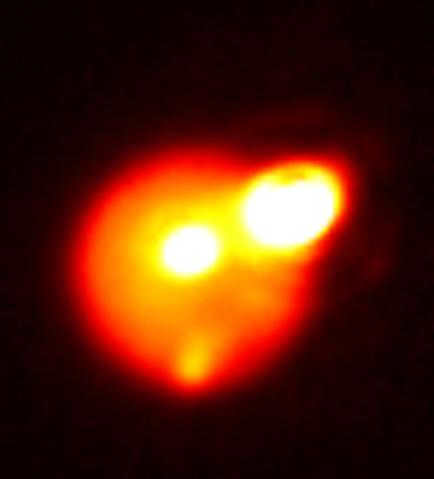
There exist approximately 400 volcanoes on Jupiter’s enigmatic moon. Some of these volcanoes produce such vigorous eruptions that they can be observed from our planet using a telescope.
Occasionally, immense fountains composed of sulfur, rock, and particulate matter rise above the moon’s surface. Following these emissions, extensive rivers of lava, spanning hundreds of kilometers, become visible on Io’s terrain.
The exceptional geological activity distinguishes Io from other moons within the solar system. Most celestial bodies of this magnitude have reached a state of stability, with their tectonic activity concluding millions of years ago or transitioning into a final phase.
Fascinating pieces of information:
- Earth and Io stand as the sole two celestial bodies exhibiting volcanism within the solar system.
- During certain eruptions, an astonishing amount of energy, up to 20 trillion watts, is unleashed. This is thousands of times greater than the energy released during volcanic activity on our planet.
- During these eruptions, towering lava fountains can reach heights of up to 500 kilometers. Occasionally, streams of sulfur are expelled into space, with particles of this substance even making their way to the surface of neighboring Europe.
Ice caps and sulfur snow.
The frozen masses of ice and the white blanket of sulfur flakes.

Scientists have a strong belief that when Io was formed in Jupiter’s orbit, it contained ice. However, due to the radiation emitted by the main planet, the water on the satellite’s surface evaporated. By closely examining photographs of the satellite, one can observe extensive snow caps in certain areas. However, this snow is quite peculiar, as it consists of layers of frozen sulfur.
As Io revolves around Jupiter, it experiences a complete shadow for a duration of two hours. During this time, the temperature on the satellite’s surface significantly drops, causing sulfur dioxide to precipitate out of the atmosphere in the form of snow. Additionally, the gas emitted from the volcanoes freezes and settles onto the ground in the form of flakes.
Aurora Borealis
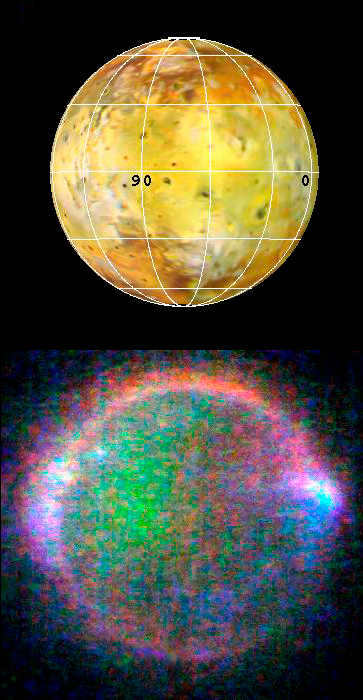

According to scientific research, Io’s surface is characterized by the presence of numerous volcanoes that release plasma into space, directly towards Jupiter’s magnetosphere. At the interaction zone between the plasma and Jupiter’s strong magnetic field, one can observe mesmerizing polar lights and clouds composed of oxygen, sodium, potassium, and sulfur. The most intense eruptions tend to occur along the equatorial region of the moon.
Odor
It might sound peculiar, but Io is the most malodorous place in the entire solar system. There is a repugnant smell reminiscent of decaying eggs. However, what is the origin of this hellish stench? It all stems from sulfur dioxide, which is emitted by volcanoes into the atmosphere of the moon.
This chemical compound is responsible for the offensive fragrance. Which do you consider preferable, a malodorous atmosphere or a vacuum? It is inconsequential, as humans are unable to breathe in either scenario.
Original research
Up until the start of the 20th century, individuals utilized homemade telescopes with limited power to observe Io, which meant that a detailed study of Jupiter’s satellite was not possible. However, the development of more advanced telescopes in the early 1900s enabled significant progress in understanding this satellite. Subsequently, space stations and probes were utilized to further explore Io.
Exploration of Io using space stations and probes:
An additional research program was initially scheduled for 2021, however, due to various circumstances, it did not receive approval. There are plans in place for a future mission to Ganymede, with the Juice spacecraft set to explore the surface of this Jupiter satellite. Specifically, its focus will be on studying the volcanoes of Io.
In summary
- The surface of Ganymede is predominantly covered with volcanoes, which continuously release substantial amounts of sulfur dioxide and other volcanic gases. Some of these gases remain on the surface, while others escape into the satellite’s atmosphere.
- Ganymede experiences active tectonic processes, resulting in volcanic eruptions and the formation and disappearance of mountains.
- Once every 40 hours, the satellite passes into the shadow of Jupiter, causing a dramatic decrease in temperature and resulting in the formation of sulfur snow on the planet’s surface. However, when the satellite emerges from Jupiter’s shadow, the snow quickly melts and returns to its gaseous form.
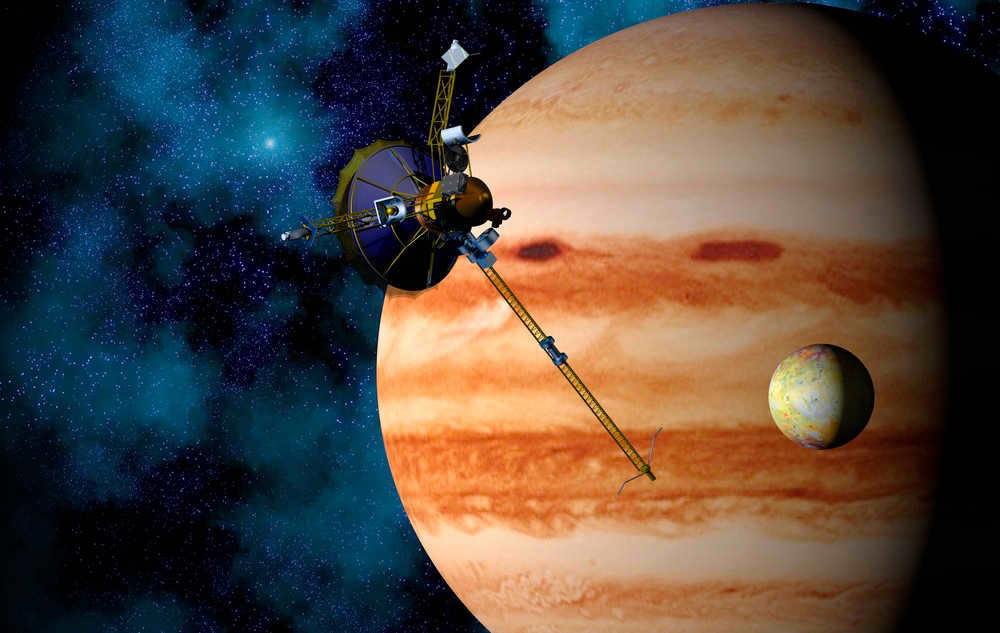

- In the past, Io was observed using telescopes. In the 20th and 21st centuries, spacecraft have been sent to study this celestial body, capturing detailed images of its surface.
- Io is renowned for having the most pungent odor in the entire solar system. The planet’s atmosphere is filled with sulfur dioxide, emitting a smell reminiscent of rotten eggs.
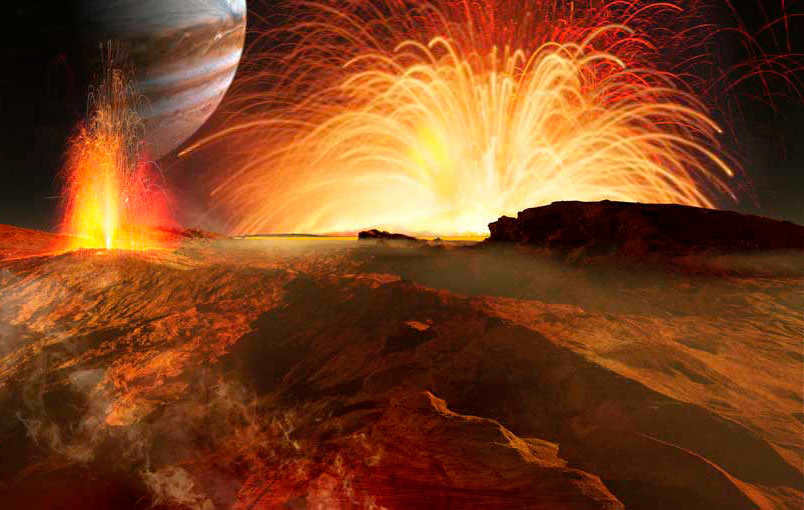
- Io is an exceptionally unique moon in our solar system. It zooms rapidly along its elliptical orbit, completing one rotation around Jupiter in just 42 hours.
- Io experiences a wide range of temperatures, from a chilling -183°C to a scorching 1526°C. The hottest areas are found in the volcanic regions, while the coldest temperatures can be found on the far side of the moon.
Research on Jupiter’s moons is ongoing. In the coming days, the spacecraft Juice will embark on a mission to explore Ganymede and extensively analyze the volcanic activity on Io.

